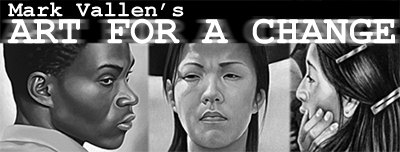On the Supremacy of Faux Censorship
The censorship of two recent art exhibits in the United States points not only to widening threats against free speech, but also to a deep crisis and malaise within the art world.
As reported on May 3, 2006 on “Democracy Now,” a current affairs news show on leftwing Pacifica Radio, Brandeis University in Massachusetts closed an exhibit of Palestinian art:
“In Boston, a free speech controversy has erupted at Brandeis University over the removal of an exhibition featuring the paintings of Palestinian youths. The exhibit’s 17 paintings depicted the young artists’ perspectives on life under Israeli military occupation. But just four days into a two-week run, the exhibit was removed by Brandeis officials after several complaints from students. A university spokesperson said the school would consider re-mounting the paintings if they were to appear alongside paintings showing an Israeli perspective. The exhibition was curated by an Israeli Jewish student who said she wanted to showcase a Palestinian perspective on campus.”
Lior Halperin is a 27-year old veteran of the Israeli Defense Force, and her censored Voices from Palestine exhibit was a final project for a class called, “The Arts of Building Peace.” The works in the show were created by Palestinian youths, and those paintings depicted the painful realities of life under military occupation. The most controversial artworks on display depicted a boy with an amputated leg, a dove perched on barbed wire, and a bulldozer threatening a girl lying in a pool of blood. On May 4th, some 100 people, many of them students at Brandeis, staged a protest against the closing of the exhibit – despite this, the censorship at Brandeis has received little attention from the art world blogoshere.
Contrast this lack of interest to the explosion of outrage over the censorship of an exhibition mounted by Brooklyn College art students.
The Brooklyn Parks Commission closed an exhibit in a city-owned building after complaints from the public regarding the show’s content. Several blogs have taken up the censorship of the graduate students at Brooklyn College as a cause celeb, the New York Times wrote a major article on the suppression of the exhibit, and the students themselves have set up a web log to present their case to the world.
Some of the works on display at the War Memorial Building contained sexually explicit images, like the minimalist but confrontational watercolors of Carl Ferrero depicting graphic gay sexuality, and the sculptures of penises by Augusto Marin. Performance artist Marni Kotak recreated an elementary school classroom – replete with a live rat in a glass enclosure. According to the New York Times, the show also “included a video with sexual overtones in which women are dressed as nuns.” The War Memorial Building comes under the jurisdiction of the Brooklyn Parks Commission, which ordered the closing of the show because it was in violation of an agreement the parks commission has with the college that “all exhibits remain family friendly.”
Obviously, artists have the perfect right to create and exhibit whatever they please, but examine Carl Ferrero’s watercolors and then tell me they should be openly displayed in a public place where children can see them. The college issued a statement that it supports the student’s artistic freedoms and that the show would be moved to a campus location.
The controversy at Brooklyn Art College would really be nothing more than a tempest in a teapot if it were not for the fact that it represents what is being taught in art schools today. As one protesting student quoted by the New York Times put it, “There’s no better way to bequeath street cred to a bunch of people who are about to enter the art world than to deem their work officially avant-garde by saying it’s too risqué for the public.” I’d like to add stupid, pointless and ugly to that list of qualifications.
I’m no stranger to controversy, and I enthusiastically back artists who defy the status quo, but there IS a difference between those proclaimed to be “officially avant-garde” and an authentic avant-garde. The entire raison d’etre of an avant-garde is to attack and overthrow the establishment – but nowadays the “shock jocks” of the art world who have abandoned formal drawing and painting in favor of the conceptual ARE the establishment.
When the pattern set by elite institutions offers nothing but a race to the bottom of mediocrity, what then is the future of art? In today’s art schools you can earn a degree by pursuing the latest controversial gimmick, guaranteeing entry into the art world… that’s a system that needs toppling.


